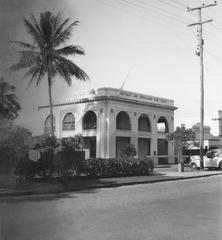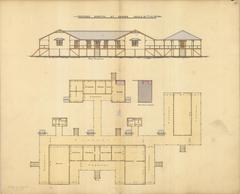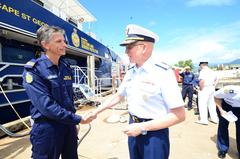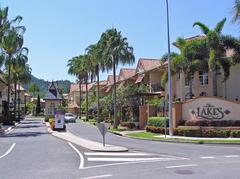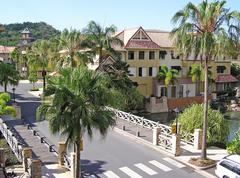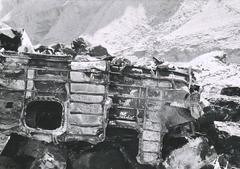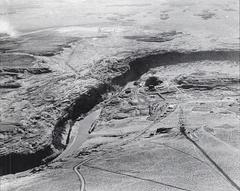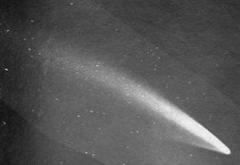Marble Canyon Visiting Hours, Tickets, and Guide to This United States Historical Site
Date: 14/06/2025
Introduction to Marble Canyon: History and Significance
Marble Canyon, situated in northern Arizona at the eastern entrance to Grand Canyon National Park, is a remarkable natural and cultural landmark. Its sheer cliffs, vibrant rock layers, and the winding Colorado River offer a window into nearly two billion years of geological history. Despite its name, the canyon’s walls are composed of polished limestone—mistaken for marble by explorer John Wesley Powell, who named the canyon during his 1869 expedition (Audiala).
For millennia, Marble Canyon has been sacred to Indigenous peoples, especially the Navajo Nation. The area abounds in petroglyphs, oral traditions, and archaeological sites, reflecting its central role as both spiritual ground and vital resource. Today, visitors can engage with Indigenous heritage through interpretive centers and guided tours, as well as experience the area’s natural beauty and ecological diversity (TheTravel, USGS Report).
Marble Canyon is also historically significant for its role in westward expansion. In 1872, John D. Lee established Lee’s Ferry, the only reliable Colorado River crossing for miles, which became a crucial link between Arizona and Utah (Parks and Trips). The area’s inclusion in Grand Canyon National Park in 1975 underscores its environmental and cultural importance, ensuring preservation and public enjoyment.
With year-round access and no general admission fee, Marble Canyon is a destination for hiking, wildlife viewing, river rafting, and exploring archaeological sites. However, some activities require permits or tickets. Proper planning, respect for cultural sites, and attention to safety guidelines are essential for a responsible and enriching experience (National Park Service, Champion Traveler).
Whether you seek adventure, cultural insight, or geological wonder, Marble Canyon offers a unique blend of natural grandeur and living heritage. This guide covers everything you need to know—from history and geology to visitor logistics and safety recommendations (Salt Lake Express, Audiala).
Table of Contents
- Early Human History and Indigenous Significance
- European Exploration and Settlement
- National Monument and Park Status
- Geological Formation and Features
- Scientific and Conservation Importance
- Marble Canyon in American Culture
- Visitor Information: Visiting Hours, Tickets, and Accessibility
- Key Historical Sites and Visitor Insights
- Indigenous and Cultural Heritage
- Archaeological Importance
- Ecological Significance
- Visitor Experience and Stewardship
- Visiting Marble Canyon: Hours, Tickets, Attractions, and Tips
- Marble Canyon Visiting Hours, Tickets, and Essential Visitor Safety Tips
- Conclusion and Visitor Recommendations
- References
Early Human History and Indigenous Significance
Marble Canyon’s cultural roots run deep. For thousands of years, Native American peoples, including the Navajo, Hopi, and ancestral Puebloans, have lived, traded, and held ceremonies here. The Navajo Nation, whose reservation borders the canyon, holds this land as sacred, and their oral histories, petroglyphs, and archaeological sites are found throughout the region (Audiala). The area’s river corridors and cliffs provided essential resources and routes; today, visitors can learn about this heritage through local cultural centers and Indigenous-led tours.
European Exploration and Settlement
John Wesley Powell’s 1869 expedition marked the first European documentation of Marble Canyon. Struck by the gleaming limestone walls, he named the canyon, launching decades of scientific exploration (Audiala). In 1872, John D. Lee established Lee’s Ferry, enabling migration and trade between Arizona and Utah (Parks and Trips). The ferry operated until 1929, when the Navajo Bridge provided a new crossing and further opened the region.
National Monument and Park Status
Designated a U.S. National Monument in 1969, Marble Canyon was incorporated into Grand Canyon National Park in 1975 (Audiala). This move recognized its geological and cultural ties to the greater Grand Canyon, ensuring protection and public access for generations to come.
Geological Formation and Features
Stratigraphy and Rock Composition
Marble Canyon’s walls are layered with sedimentary rocks—primarily limestone and sandstone—deposited over hundreds of millions of years (Audiala). The “marble” is actually limestone, polished by the elements. The region’s strata mirror those of the Grand Canyon, revealing marine, riverine, and volcanic histories—from the Kaibab Limestone at the top to the ancient Vishnu Basement Rocks at the bottom (National Parks Around the World).
Erosional Processes and Canyon Formation
Over five to six million years, the Colorado River has carved Marble Canyon through the uplifted Colorado Plateau, creating sheer cliffs and exposing ancient rock layers (National Parks Around the World). The canyon stretches about 60 miles from Glen Canyon Dam to the Little Colorado River confluence (Parks and Trips).
Unique Geological Features
The Navajo Bridge, a spectacular engineering feat, spans 470 feet above the river and offers panoramic views. The area features natural stone bridges, alcoves, and the photogenic Horseshoe Bend, a meander in the Colorado River (Parks and Trips).
Scientific and Conservation Importance
Marble Canyon’s exposed rock layers provide vital information for geologists and ecologists (National Parks Around the World). The area supports unique flora and fauna, including endangered species like the California condor (Audiala). Ongoing conservation efforts aim to preserve these natural and cultural resources for future generations.
Marble Canyon in American Culture
Marble Canyon’s rugged beauty has inspired countless artists and adventurers, symbolizing the spirit of the American West (National Parks Around the World). As the “gateway” to the Grand Canyon, it remains a bucket-list destination for travelers.
Visitor Information: Visiting Hours, Tickets, and Accessibility
- Visiting Hours: Open year-round, typically sunrise to sunset. Confirm hours for specific sites and visitor centers.
- Tickets: No general admission fee; permits required for river trips, guided tours, and certain activities (Parks and Trips).
- Accessibility: The Navajo Bridge area and interpretive center are wheelchair accessible. Trail and river access varies in difficulty.
- Travel Tips: The nearest airport is in Flagstaff, Arizona. Bring water, sun protection, and sturdy footwear; check weather and river conditions before visiting.
Key Historical Sites and Visitor Insights
- Lee’s Ferry: Historic crossing and launch point for river trips.
- Navajo Bridge Interpretive Center: Offers exhibits on geology, history, and ecology.
- Lonely Dell Ranch: Preserved pioneer homestead dating to the 19th century (Audiala).
- Archaeological Sites: Explore petroglyphs and ancient dwellings.
Visitors are urged to respect cultural and ecological sensitivities, stay on designated trails, and support conservation (Audiala).
Indigenous and Cultural Heritage
Native American Significance
Marble Canyon lies along the western edge of the Navajo Nation, the largest reservation in the U.S. The region’s proximity to Hopi and other Indigenous lands underscores its significance as a cultural crossroads (TheTravel). The river and canyon have long provided vital resources and sacred spaces for ceremonies and daily life.
Cairns and Stacked Stones
Indigenous peoples built cairns as markers for trails, water sources, and sacred sites (SuchScience). Visitors should respect existing cairns and avoid building new ones, as unauthorized stacks can disrupt traditional navigation and the natural landscape.
Archaeological Importance
Prehistoric and Historic Sites
Marble Canyon and the greater Grand Canyon corridor contain hundreds of archaeological sites, from rock art and granaries to habitation sites (USGS Report). These testify to thousands of years of Indigenous presence and adaptation.
Modern Threats and Conservation
Natural erosion, river flow changes due to Glen Canyon Dam, and increased visitation threaten archaeological resources. Site monitoring, public education, and strict protection are essential (USGS Report).
Ecological Significance
Unique Geology and Habitats
Marble Canyon’s polished limestone cliffs, riparian zones, and arid uplands support diverse plant and animal species. Notable habitats include willows and cottonwoods along the river, desert flora on uplands, and native fish in the Colorado River (TheTravel).
Impact of Glen Canyon Dam
Glen Canyon Dam altered river flows, water temperatures, and sediment transport, affecting native fish and riparian habitats (USGS Report). Adaptive management aims to balance recreation, habitat conservation, and cultural preservation.
Visitor Experience and Stewardship
Responsible Recreation
Popular activities include hiking, fishing, river rafting, and photography (TheTravel). Lee’s Ferry is the main launch point for rafting expeditions. Practice Leave No Trace principles, and do not disturb archaeological features or wildlife.
Interpretation and Education
Visitor centers and interpretive signage offer information on geology, ecology, and culture. Ranger-led programs and Indigenous-guided tours provide deeper insight (Global National Parks).
Community and Indigenous Partnerships
Collaborative management with Native American tribes and local communities ensures that traditional knowledge and sacred sites are respected (TheTravel).
Visiting Marble Canyon: Hours, Tickets, Attractions, and Tips
Hours and Access
- Lee’s Ferry Visitor Center: Daily, 8:00 AM–5:00 PM
- Navajo Bridge Visitor Center: Daily, 9:00 AM–4:30 PM
- Vermilion Cliffs National Monument: Open year-round
Permits and Tickets
- River Trips: Permits required for rafting/kayaking; apply via the National Park Service lottery.
- The Wave: Permit lottery for access to this iconic sandstone formation.
- Camping: Backcountry permits required in some areas; check with the BLM and NPS.
Attractions
- Lee’s Ferry: Fishing, picnicking, and hiking to Lonely Dell Ranch.
- Navajo Bridge: Vantage point for condor viewing and scenic photography.
- Vermilion Cliffs/White Pocket: Rugged wilderness and swirling sandstone (high-clearance vehicles required).
- Slot Canyons: The Wave and other canyons offer unique hiking and photography.
Travel Tips
- Best Time: Spring and fall for mild temperatures and fewer crowds.
- Facilities: Limited services outside visitor centers; bring essentials.
- Safety: Hydrate, use sun protection, and be cautious near cliffs and in slot canyons.
Marble Canyon Visiting Hours, Tickets, and Essential Visitor Safety Tips
Visiting Hours and Tickets
- Open year-round, typically sunrise to sunset.
- Entry is free; permits/tickets are required for some tours, rafting, and camping (Champion Traveler, Salt Lake Express).
Weather and Best Times
- Spring/Fall: Mild temperatures, less crowded.
- Summer: Hot; plan early morning activities.
- Winter: Cold, fewer visitors.
Safety Tips
- Stay on marked trails; cairns guide safe passage (Walking Academy).
- Bring plenty of water and sun protection.
- Be prepared for limited cell service and remote conditions.
- Respect wildlife; watch for rattlesnakes.
- Use life jackets for river activities.
- Carry a first aid kit and inform someone of your plans.
Packing and Accessibility
- Layered clothing, sturdy boots, binoculars, camera, and maps recommended.
- Facilities are limited; check accessibility for specific sites.
Cultural Etiquette
- Do not disturb archaeological sites or cairns.
- Follow local regulations and respect sacred areas (Walking Academy).
Visual Highlights and Media
Alt text: Scenic view of Marble Canyon’s limestone cliffs and the Colorado River
For more visuals, explore interactive maps and virtual tours from official resources and visitor centers.
Frequently Asked Questions (FAQ)
Q: What are Marble Canyon’s visiting hours?
A: Open year-round, sunrise to sunset. Check visitor center hours for specifics.
Q: Do I need tickets?
A: General entry is free; permits required for river trips, camping, and some hikes.
Q: Are guided tours available?
A: Yes, guided tours are available for rafting, hiking, and cultural experiences.
Q: When is the best time to visit?
A: Spring and fall offer the best conditions.
Q: Is Marble Canyon accessible?
A: Some areas are accessible, but facilities are limited.
Q: Are pets allowed?
A: Pets may be allowed on certain trails; always check local regulations.
Q: Is there cell phone coverage?
A: Coverage is limited; download maps and contacts in advance.
Conclusion and Visitor Recommendations
Marble Canyon is a place where natural beauty, deep history, and vibrant culture converge. Its cliffs and river tell the Earth’s story, while its petroglyphs and sacred sites honor the enduring presence of Native American peoples (Audiala, USGS Report). As part of Grand Canyon National Park, it is preserved for exploration and reflection.
To make the most of your visit, plan ahead, respect cultural and natural resources, and consider guided tours for the deepest insights (National Park Service, TheTravel). Use official resources and the Audiala app for up-to-date information and maps. Above all, approach Marble Canyon with curiosity and care, ensuring it remains a place of wonder for generations to come.
References
- Audiala - Exploring Marble Canyon: Visiting Hours, Tickets, and Historical Insights in Arizona
- TheTravel - Marble Canyon Visiting Hours, Tickets, and Cultural Significance
- USGS - Archaeological and Ecological Report
- Parks and Trips - Exploring Marble Canyon: The Start of the Grand Canyon
- National Park Service - Visiting Marble Canyon: Hours, Tickets, Attractions, and Tips
- Champion Traveler - Best Time to Visit Marble Canyon
- Salt Lake Express - Marble Canyon Activities and Safety
- Walking Academy - Cairn Etiquette and Cultural Significance

